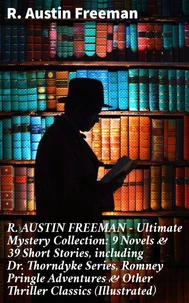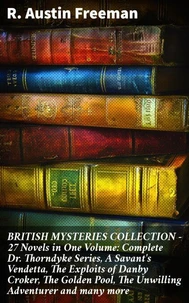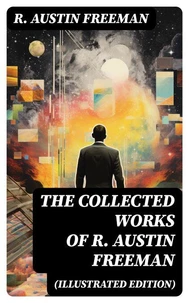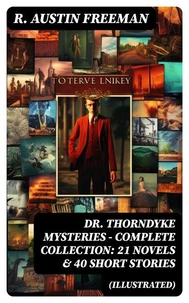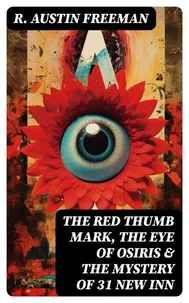The Eye of Osiris. An Intriguing Blend of Forensic Science and Mystery in Victorian London
Par :Formats :
Disponible dans votre compte client Decitre ou Furet du Nord dès validation de votre commande. Le format ePub est :
- Compatible avec une lecture sur My Vivlio (smartphone, tablette, ordinateur)
- Compatible avec une lecture sur liseuses Vivlio
- Pour les liseuses autres que Vivlio, vous devez utiliser le logiciel Adobe Digital Edition. Non compatible avec la lecture sur les liseuses Kindle, Remarkable et Sony
 , qui est-ce ?
, qui est-ce ?Notre partenaire de plateforme de lecture numérique où vous retrouverez l'ensemble de vos ebooks gratuitement
Pour en savoir plus sur nos ebooks, consultez notre aide en ligne ici
- Nombre de pages296
- FormatePub
- ISBN4057664640574
- EAN4057664640574
- Date de parution22/11/2019
- Protection num.Digital Watermarking
- Taille583 Ko
- Infos supplémentairesepub
- ÉditeurGOOD PRESS
Résumé
In "The Eye of Osiris, " R. Austin Freeman continues to cement his reputation as a master of the detective genre, intertwining elements of medical science with intricate mystery. This novel showcases the adventures of Dr. John Thorndyke, a forensic physician whose analytical prowess unravels a complex crime involving ancient Egyptian artifacts. Freeman's literary style is characterized by meticulous attention to detail and a deft incorporation of scientific reasoning into the narrative, thus placing the novel firmly within the context of early 20th-century detective fiction, which often straddles the line between intellectual pursuit and thrilling discovery.
R. Austin Freeman, a former medical student and active physician, drew upon his extensive knowledge of forensic science to craft narratives that are both engaging and educational. His background in medicine not only informs the logical structure of his mysteries but also reflects the era's burgeoning interest in the scientific explanations of crime, adding depth to his characters and their investigative processes.
Freeman's Thorndyke is an amalgamation of the rational and the relatable, a quintessential Victorian detective whose methods predate and prefigure later fictional sleuths. For readers and enthusiasts of classic detective stories, "The Eye of Osiris" is a compelling blend of mystery and scientific inquiry that mesmerizes from the first page to the last. Freeman's ability to weave meticulous detail into an engaging narrative invites readers to partake in the intellectual challenge of solving the crime alongside Thorndyke.
This novel is highly recommended for anyone interested in the evolution of the detective genre and the intersection of science and literature.
R. Austin Freeman, a former medical student and active physician, drew upon his extensive knowledge of forensic science to craft narratives that are both engaging and educational. His background in medicine not only informs the logical structure of his mysteries but also reflects the era's burgeoning interest in the scientific explanations of crime, adding depth to his characters and their investigative processes.
Freeman's Thorndyke is an amalgamation of the rational and the relatable, a quintessential Victorian detective whose methods predate and prefigure later fictional sleuths. For readers and enthusiasts of classic detective stories, "The Eye of Osiris" is a compelling blend of mystery and scientific inquiry that mesmerizes from the first page to the last. Freeman's ability to weave meticulous detail into an engaging narrative invites readers to partake in the intellectual challenge of solving the crime alongside Thorndyke.
This novel is highly recommended for anyone interested in the evolution of the detective genre and the intersection of science and literature.
In "The Eye of Osiris, " R. Austin Freeman continues to cement his reputation as a master of the detective genre, intertwining elements of medical science with intricate mystery. This novel showcases the adventures of Dr. John Thorndyke, a forensic physician whose analytical prowess unravels a complex crime involving ancient Egyptian artifacts. Freeman's literary style is characterized by meticulous attention to detail and a deft incorporation of scientific reasoning into the narrative, thus placing the novel firmly within the context of early 20th-century detective fiction, which often straddles the line between intellectual pursuit and thrilling discovery.
R. Austin Freeman, a former medical student and active physician, drew upon his extensive knowledge of forensic science to craft narratives that are both engaging and educational. His background in medicine not only informs the logical structure of his mysteries but also reflects the era's burgeoning interest in the scientific explanations of crime, adding depth to his characters and their investigative processes.
Freeman's Thorndyke is an amalgamation of the rational and the relatable, a quintessential Victorian detective whose methods predate and prefigure later fictional sleuths. For readers and enthusiasts of classic detective stories, "The Eye of Osiris" is a compelling blend of mystery and scientific inquiry that mesmerizes from the first page to the last. Freeman's ability to weave meticulous detail into an engaging narrative invites readers to partake in the intellectual challenge of solving the crime alongside Thorndyke.
This novel is highly recommended for anyone interested in the evolution of the detective genre and the intersection of science and literature.
R. Austin Freeman, a former medical student and active physician, drew upon his extensive knowledge of forensic science to craft narratives that are both engaging and educational. His background in medicine not only informs the logical structure of his mysteries but also reflects the era's burgeoning interest in the scientific explanations of crime, adding depth to his characters and their investigative processes.
Freeman's Thorndyke is an amalgamation of the rational and the relatable, a quintessential Victorian detective whose methods predate and prefigure later fictional sleuths. For readers and enthusiasts of classic detective stories, "The Eye of Osiris" is a compelling blend of mystery and scientific inquiry that mesmerizes from the first page to the last. Freeman's ability to weave meticulous detail into an engaging narrative invites readers to partake in the intellectual challenge of solving the crime alongside Thorndyke.
This novel is highly recommended for anyone interested in the evolution of the detective genre and the intersection of science and literature.



